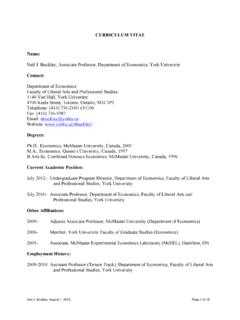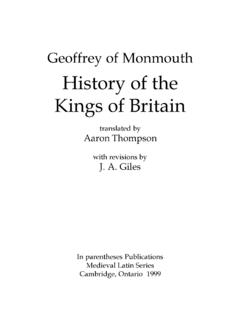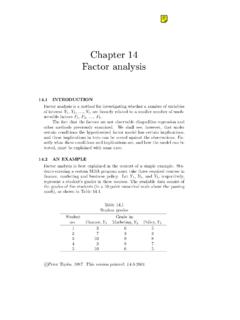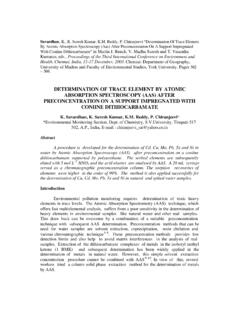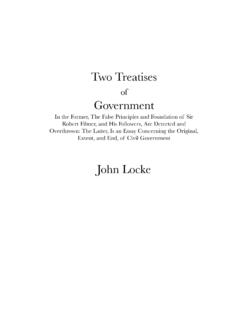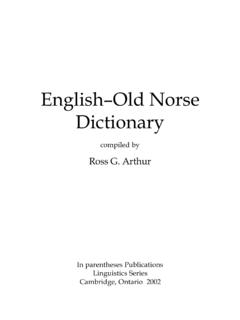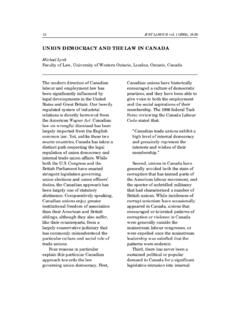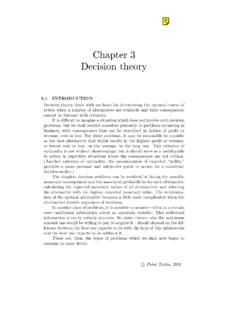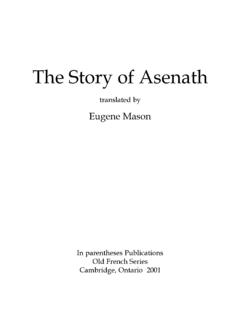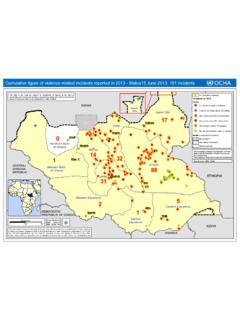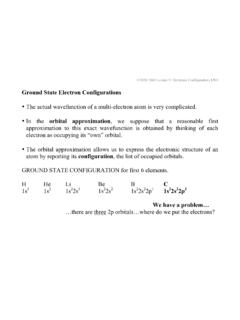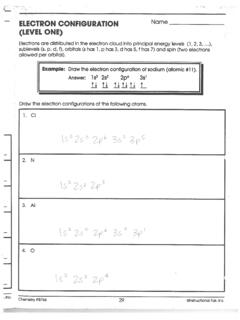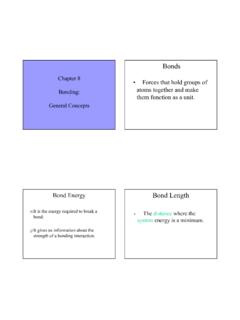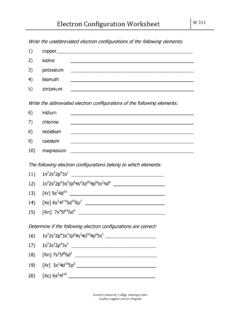Transcription of The 16 and 18 Electron Rule in Organometallic Chemistry ...
1 The 16 and 18 Electron Rule in Organometallic Chemistry and Homogeneous Catalysis By C. A. Tolman c E N T RA L R E S E A R C H DEPARTMENT* E X P E R I M E N T A L STATION, E. I . D U P O N T D E N E M O U R S A N D C O M P A N Y , W I L M I N G T O N , D E L A W A R E 1 9 8 9 8 , 1 Introduction There has been a great increase in interest and activity in recent years in organo- metallic Chemistry , especially in the area of homogeneous catalysis by transition- metal complexes. A number of publications have appeared dealing with par- ticular Organometallic reactions which occur in catalysis, such as oxidative addition,lJ insertion,, ligand e~change,~ and reactions of complexes with Lewis few authors have attempted to outline the principles of catalysis more There appears, however, to be no satisfactory scheme which relates the various reaction types or which permits mechanistic predictions.
2 In this review the various types of Organometallic reactions involved in catalysis are organized in a systematic way, and some empirical rules are pre- sented which may be used predictively to restrict the kinds of Organometallic compounds which may exist under mild conditions and the types of reactions they may undergo. The tendency of transition metals to form complexes in which the metal has an effective atomic number corresponding to the next higher inert gas has long been recogni~ed.~ There are, however, many exceptions, as illustrated by the following examples: Compound NVE.
3 TiClc 8. MeAuPPh, 14. Co(CN),S- 17. Ni(HzO)5z+ 20. The number of valence electrons (NVE) consists of the valence electrons of the * Contribution No. 1821. J. P. Collman, Accounts Chem. Res., 1968, 1, 136; J. P. Collman and W. R. Roper, Adv, Organometallic Chem., 1968, 7 , 53. J. Halpern, Accounts Chem. Res., 1970, 3, 386. a R. F. Heck, Adv. Chem. Ser., 1965, 49, 181. C. H. Langford and H. B. Gray, Ligand Substitution Processes', Benjamin, New York. 1965. D. F. Shriver, Accounts Chem. Res., 1970, 3, 231. J. Halpern, Discuss. Faraday SOC.
4 ,1968, 46,7. J. Halpern, Adv. Chem. Ser., 1968, 70, 1. * R. Ugo, Chimica e Industria, 1969, 51, 1319. N. V. Sidgwick, The Electronic Theory of Valency', ,London, 1929, p. 163. 337. 16 and 18 Electron Rule in Organometallic Chemistry and Homogeneous Catalysis metal and those electrons donated by or shared with the ligands, and would be 18 for an inert-gas configuration . If, however, one restricts attention to the diamagnetic Organometallic complexes of Groups IVB-VIII, essentially all of the well-characterized compounds have 16 or 18 metal valence This fact has not generally been adequately appreciated by Organometallic chemists.
5 In fact, the literature contains numerous examples of Organometallic compounds which, as formulated, appeared to be exceptions to what can be called the 16 and 18 Electron Rule. Careful subsequent study has almostinvari- ably shown that the original formulation was incorrect. The accessibility of 16. and 18 Electron configurations also has important consequences for mechanisms of Organometallic reactions, as outlined below. Organometallic compounds, for the purposes of this discussion, are transition- metal complexes containing one or more ligands such as CO, N2, CN-, RNC, PR3, P(OR)3, olefin, acetylene, n-allyl, 7r-cyclopentadienyl, 7r-aryl, acyl, -SiR3, -R, or -H.
6 These soft'lBor class b'lSligands are characterized by a high ligand- field strength and covalent bonding character and are the types typically found in homogeneous catalytic reactions such as hydrogenation, hydroformylation, hydrosilylation, and olefin isomerization and oligomerization. The 16 and 18 Electron postulates or rules for Organometallic com- plexes and their reactions are proposed. 1. Diamagnetic Organometallic complexes of transition metals may exist in a significant concentration at moderate temperatures only if the metal's valence shell contains 16 or 18 electrons.
7 A significant concentration is one that may be detected spectroscopically or kinetically and may be in the gaseous, liquid, or solid state. 2. Organometallic reactions, including catalytic ones, proceed by elementary steps involving only intermediates with 16 or 18 metal valence electrons. It is apparent that application of these rules requires that care be exercised in reaching conclusions on the NVE of a metal complex. Association or dissociation of the compound may occur. For example, Ni[PPh3I4is substantially dissociated in solution into Ni[PPh3I3and palladium chloride is a 16 Electron complex, with chloride ions bridging in a dimeric Polyfunctional ligands may co-ordinate at more than one site, and additional M-C and M-H.]]
8 Bonds may form by reaction of a metal with C-H bonds of the When the complex is in solution, there is a potential ambiguity as to whether solvent is co-ordinated. The mere presence of solvent in the analysis of a crystal- line solid is not good evidencefor solvent co-ordination. One convenient criterion lo F. Basolo and R. G. Pearson, Mechanisms of Inorganic Reactions', Wiley, New York, 1967, p. 526. I1 G. E. Coates, M. L. H. Green, and K. Wade, Organometallic Compounds', 1'01. 2, The Transition Elements', Methuen and Co., Ltd.
9 , London, 1968, p. 6. l* R. G. Pearson, Science, 1966, 151, 172. S. Ahrland, J. Chatt, and N. R. Davies, Quart. Rev., 1958, 12, 265. l4 C. A. Tolman, W. C. Seidel, and D. H. Gerlach, J. Amer. Chem. SOC.,1972, 94, 2669. l6 W. E. Oberhansli and L. F. Dahl, J. Organometallic Chem., 1965, 3, 43. G. W. Parshall, Accounts Chem. Res., 1970, 3, 139. 338. Tolman for solution studies is whether the electronic spectrum of the complex is sub- stantially different in different solvents. Frequently a coloured complex will give dramatic colour changes when dissolved in a co-ordinating solvent.
10 For example, N i [ P ( O ~ - t o l y l ) ~a] ~red-orange ,~~ solid, gives red-orange solutions in benzene, tetrahydrofuran, or methylene chloride, in which it remains three-co-ordinate, but gives a colourless solution in acetonitrile, from which the unstable adduct MeCNNi[P(Oo-tolyl),I3 has been isolated.'. 2 Types of Organometallic Reactions Reactions of ligands which do not directly involve the transition metal are ex- cluded from this examples of such reactions are methanolysis of Ni(PF& to give Ni(PF,) ,[PF,-n(OMe)n], Friedel-Crafts acylation of ferro- cene, and nucleophilic attack on a co-ordinated carbonyl by methoxide ion.)]
